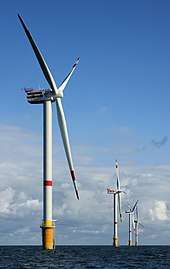Renewable energy
Renewable energy is energy that is collected from renewable resources, which are naturally replenished on a human timescale, such as sunlight, wind, rain, tides, waves, and geothermal heat.[3] Renewable energy often provides energy in four important areas: electricity generation, air and water heating/cooling, transportation, and rural (off-grid) energy services.[4]
| Part of a series about |
| Sustainable energy |
|---|
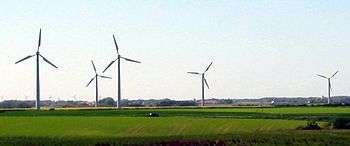 |
| Overview |
| Energy conservation |
| Renewable energy |
| Sustainable transport |
|
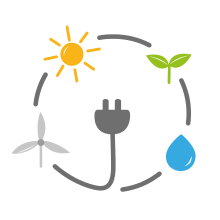
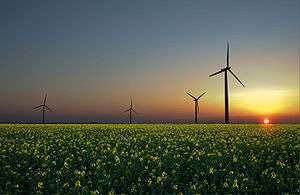
Based on REN21's 2017 report, renewables contributed 19.3% to humans' global energy consumption and 24.5% to their generation of electricity in 2015 and 2016, respectively. This energy consumption is divided as 8.9% coming from traditional biomass, 4.2% as heat energy (modern biomass, geothermal and solar heat), 3.9% from hydroelectricity and the remaining 2.2% is electricity from wind, solar, geothermal, and other forms of biomass. Worldwide investments in renewable technologies amounted to more than US$286 billion in 2015.[5] In 2017, worldwide investments in renewable energy amounted to US$279.8 billion with China accounting for US$126.6 billion or 45% of the global investments, the United States for US$40.5 billion and Europe for US$40.9 billion.[6] Globally there are an estimated 7.7 million jobs associated with the renewable energy industries, with solar photovoltaics being the largest renewable employer.[7] Renewable energy systems are rapidly becoming more efficient and cheaper and their share of total energy consumption is increasing.[8] As of 2019, more than two-thirds of worldwide newly installed electricity capacity was renewable.[9] Growth in consumption of coal and oil could end by 2020 due to increased uptake of renewables and natural gas.[10][11]
At the national level, at least 30 nations around the world already have renewable energy contributing more than 20 percent of energy supply. National renewable energy markets are projected to continue to grow strongly in the coming decade and beyond.[12] Some places and at least two countries, Iceland and Norway, generate all their electricity using renewable energy already, and many other countries have the set a goal to reach 100% renewable energy in the future.[13] At least 47 nations around the world already have over 50 percent of electricity from renewable resources.[14][15][16] Renewable energy resources exist over wide geographical areas, in contrast to fossil fuels, which are concentrated in a limited number of countries. Rapid deployment of renewable energy and energy efficiency technologies is resulting in significant energy security, climate change mitigation, and economic benefits.[17] In international public opinion surveys there is strong support for promoting renewable sources such as solar power and wind power.[18][19]
While many renewable energy projects are large-scale, renewable technologies are also suited to rural and remote areas and developing countries, where energy is often crucial in human development.[20] As most of renewable energy technologies provide electricity, renewable energy deployment is often applied in conjunction with further electrification, which has several benefits: electricity can be converted to heat (where necessary generating higher temperatures than fossil fuels), can be converted into mechanical energy with high efficiency, and is clean at the point of consumption.[21][22] In addition, electrification with renewable energy is more efficient and therefore leads to significant reductions in primary energy requirements.[23]
Overview
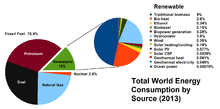
Renewable energy flows involve natural phenomena such as sunlight, wind, tides, plant growth, and geothermal heat, as the International Energy Agency explains:[24]
Renewable energy is derived from natural processes that are replenished constantly. In its various forms, it derives directly from the sun, or from heat generated deep within the earth. Included in the definition is electricity and heat generated from solar, wind, ocean, hydropower, biomass, geothermal resources, and biofuels and hydrogen derived from renewable resources.
Renewable energy resources and significant opportunities for energy efficiency exist over wide geographical areas, in contrast to other energy sources, which are concentrated in a limited number of countries. Rapid deployment of renewable energy and energy efficiency, and technological diversification of energy sources, would result in significant energy security and economic benefits.[17] It would also reduce environmental pollution such as air pollution caused by burning of fossil fuels and improve public health, reduce premature mortalities due to pollution and save associated health costs that amount to several hundred billion dollars annually only in the United States.[25] Renewable energy sources, that derive their energy from the sun, either directly or indirectly, such as hydro and wind, are expected to be capable of supplying humanity energy for almost another 1 billion years, at which point the predicted increase in heat from the Sun is expected to make the surface of the Earth too hot for liquid water to exist.[26][27][28]
Climate change and global warming concerns, coupled with the continuing fall in the costs of some renewable energy equipment, such as wind turbines and solar panels, are driving increased use of renewables.[18] New government spending, regulation and policies helped the industry weather the global financial crisis better than many other sectors.[29] As of 2019, however, according to the International Renewable Energy Agency, renewables overall share in the energy mix (including power, heat and transport) needs to grow six times faster, in order to keep the rise in average global temperatures "well below" 2.0 °C (3.6 °F) during the present century, compared to pre-industrial levels.[30]
As of 2011, small solar PV systems provide electricity to a few million households, and micro-hydro configured into mini-grids serves many more. Over 44 million households use biogas made in household-scale digesters for lighting and/or cooking, and more than 166 million households rely on a new generation of more-efficient biomass cookstoves.[31] United Nations' eighth Secretary-General Ban Ki-moon has said that renewable energy has the ability to lift the poorest nations to new levels of prosperity.[32] At the national level, at least 30 nations around the world already have renewable energy contributing more than 20% of energy supply. National renewable energy markets are projected to continue to grow strongly in the coming decade and beyond, and some 120 countries have various policy targets for longer-term shares of renewable energy, including a 20% target of all electricity generated for the European Union by 2020. Some countries have much higher long-term policy targets of up to 100% renewables. Outside Europe, a diverse group of 20 or more other countries target renewable energy shares in the 2020–2030 time frame that range from 10% to 50%.[12]
Renewable energy often displaces conventional fuels in four areas: electricity generation, hot water/space heating, transportation, and rural (off-grid) energy services:[4]
- Power generation
- By 2040, renewable energy is projected to equal coal and natural gas electricity generation. Several jurisdictions, including Denmark, Germany, the state of South Australia and some US states have achieved high integration of variable renewables. For example, in 2015 wind power met 42% of electricity demand in Denmark, 23.2% in Portugal and 15.5% in Uruguay. Interconnectors enable countries to balance electricity systems by allowing the import and export of renewable energy. Innovative hybrid systems have emerged between countries and regions.[33]
- Heating
- Solar water heating makes an important contribution to renewable heat in many countries, most notably in China, which now has 70% of the global total (180 GWth). Most of these systems are installed on multi-family apartment buildings and meet a portion of the hot water needs of an estimated 50–60 million households in China. Worldwide, total installed solar water heating systems meet a portion of the water heating needs of over 70 million households. The use of biomass for heating continues to grow as well. In Sweden, national use of biomass energy has surpassed that of oil. Direct geothermal for heating is also growing rapidly.[34] The newest addition to Heating is from Geothermal Heat Pumps which provide both heating and cooling, and also flatten the electric demand curve and are thus an increasing national priority[35][36] (see also Renewable thermal energy).
- Transportation

- Bioethanol is an alcohol made by fermentation, mostly from carbohydrates produced in sugar or starch crops such as corn, sugarcane, or sweet sorghum. Cellulosic biomass, derived from non-food sources such as trees and grasses is also being developed as a feedstock for ethanol production. Ethanol can be used as a fuel for vehicles in its pure form, but it is usually used as a gasoline additive to increase octane and improve vehicle emissions. Bioethanol is widely used in the USA and in Brazil. Biodiesel can be used as a fuel for vehicles in its pure form, but it is usually used as a diesel additive to reduce levels of particulates, carbon monoxide, and hydrocarbons from diesel-powered vehicles. Biodiesel is produced from oils or fats using transesterification and is the most common biofuel in Europe.
- A solar vehicle is an electric vehicle powered completely or significantly by direct solar energy. Usually, photovoltaic (PV) cells contained in solar panels convert the sun's energy directly into electric energy. The term "solar vehicle" usually implies that solar energy is used to power all or part of a vehicle's propulsion. Solar power may be also used to provide power for communications or controls or other auxiliary functions. Solar vehicles are not sold as practical day-to-day transportation devices at present, but are primarily demonstration vehicles and engineering exercises, often sponsored by government agencies. High-profile examples include PlanetSolar and Solar Impulse. However, indirectly solar-charged vehicles are widespread and solar boats are available commercially.
History
Prior to the development of coal in the mid 19th century, nearly all energy used was renewable. Almost without a doubt the oldest known use of renewable energy, in the form of traditional biomass to fuel fires, dates from more than a million years ago. Use of biomass for fire did not become commonplace until many hundreds of thousands of years later.[37] Probably the second oldest usage of renewable energy is harnessing the wind in order to drive ships over water. This practice can be traced back some 7000 years, to ships in the Persian Gulf and on the Nile.[38] From hot springs, geothermal energy has been used for bathing since Paleolithic times and for space heating since ancient Roman times.[39] Moving into the time of recorded history, the primary sources of traditional renewable energy were human labor, animal power, water power, wind, in grain crushing windmills, and firewood, a traditional biomass.
In the 1860s and 1870s there were already fears that civilization would run out of fossil fuels and the need was felt for a better source. In 1873 Professor Augustin Mouchot wrote:
The time will arrive when the industry of Europe will cease to find those natural resources, so necessary for it. Petroleum springs and coal mines are not inexhaustible but are rapidly diminishing in many places. Will man, then, return to the power of water and wind? Or will he emigrate where the most powerful source of heat sends its rays to all? History will show what will come.[40]
In 1885, Werner von Siemens, commenting on the discovery of the photovoltaic effect in the solid state, wrote:
In conclusion, I would say that however great the scientific importance of this discovery may be, its practical value will be no less obvious when we reflect that the supply of solar energy is both without limit and without cost, and that it will continue to pour down upon us for countless ages after all the coal deposits of the earth have been exhausted and forgotten.[41]
Max Weber mentioned the end of fossil fuel in the concluding paragraphs of his Die protestantische Ethik und der Geist des Kapitalismus (The Protestant Ethic and the Spirit of Capitalism), published in 1905.[42] Development of solar engines continued until the outbreak of World War I. The importance of solar energy was recognized in a 1911 Scientific American article: "in the far distant future, natural fuels having been exhausted [solar power] will remain as the only means of existence of the human race".[43]
The theory of peak oil was published in 1956.[44] In the 1970s environmentalists promoted the development of renewable energy both as a replacement for the eventual depletion of oil, as well as for an escape from dependence on oil, and the first electricity-generating wind turbines appeared. Solar had long been used for heating and cooling, but solar panels were too costly to build solar farms until 1980.[45]
Mainstream technologies
Wind power
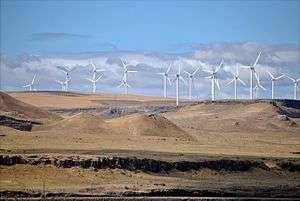
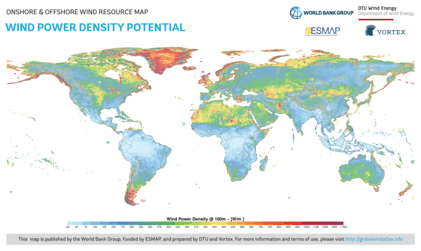
In 2018, worldwide installed capacity of wind power was 564 GW.[47]
Air flow can be used to run wind turbines. Modern utility-scale wind turbines range from around 600 kW to 9 MW of rated power. The power available from the wind is a function of the cube of the wind speed, so as wind speed increases, power output increases up to the maximum output for the particular turbine.[48] Areas where winds are stronger and more constant, such as offshore and high-altitude sites, are preferred locations for wind farms. Typically, full load hours of wind turbines vary between 16 and 57 percent annually, but might be higher in particularly favorable offshore sites.[49]
Wind-generated electricity met nearly 4% of global electricity demand in 2015, with nearly 63 GW of new wind power capacity installed. Wind energy was the leading source of new capacity in Europe, the US and Canada, and the second largest in China. In Denmark, wind energy met more than 40% of its electricity demand while Ireland, Portugal and Spain each met nearly 20%.
Globally, the long-term technical potential of wind energy is believed to be five times total current global energy production, or 40 times current electricity demand, assuming all practical barriers needed were overcome. This would require wind turbines to be installed over large areas, particularly in areas of higher wind resources, such as offshore. As offshore wind speeds average ~90% greater than that of land, so offshore resources can contribute substantially more energy than land-stationed turbines.[50]
Hydropower
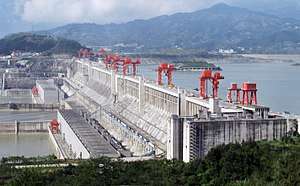
In 2017, worldwide renewable hydropower capacity was 1,154 GW.[15]
Since water is about 800 times denser than air, even a slow flowing stream of water, or moderate sea swell, can yield considerable amounts of energy. There are many forms of water energy:
- Historically, hydroelectric power came from constructing large hydroelectric dams and reservoirs, which are still popular in developing countries.[51] The largest of them are the Three Gorges Dam (2003) in China and the Itaipu Dam (1984) built by Brazil and Paraguay.
- Small hydro systems are hydroelectric power installations that typically produce up to 50 MW of power. They are often used on small rivers or as a low-impact development on larger rivers. China is the largest producer of hydroelectricity in the world and has more than 45,000 small hydro installations.[52]
- Run-of-the-river hydroelectricity plants derive energy from rivers without the creation of a large reservoir. The water is typically conveyed along the side of the river valley (using channels, pipes and/or tunnels) until it is high above the valley floor, whereupon it can allowed to fall through a penstock to drive a turbine. This style of generation may still produce a large amount of electricity, such as the Chief Joseph Dam on the Columbia river in the United States.[53] Many run-of-the-river hydro power plants are micro hydro or pico hydro plants.
Hydropower is produced in 150 countries, with the Asia-Pacific region generating 32 percent of global hydropower in 2010. For countries having the largest percentage of electricity from renewables, the top 50 are primarily hydroelectric. China is the largest hydroelectricity producer, with 721 terawatt-hours of production in 2010, representing around 17 percent of domestic electricity use. There are now three hydroelectricity stations larger than 10 GW: the Three Gorges Dam in China, Itaipu Dam across the Brazil/Paraguay border, and Guri Dam in Venezuela.[54]
Wave power, which captures the energy of ocean surface waves, and tidal power, converting the energy of tides, are two forms of hydropower with future potential; however, they are not yet widely employed commercially. A demonstration project operated by the Ocean Renewable Power Company on the coast of Maine, and connected to the grid, harnesses tidal power from the Bay of Fundy, location of world's highest tidal flow. Ocean thermal energy conversion, which uses the temperature difference between cooler deep and warmer surface waters, currently has no economic feasibility.[55][56]
Solar energy
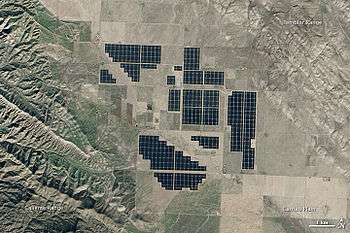
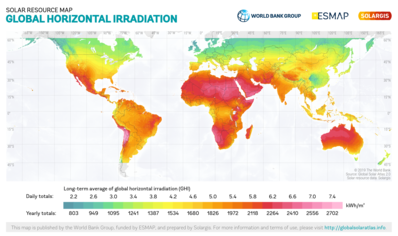
In 2017, global installed solar capacity was 390 GW.[15]
Solar energy, radiant light and heat from the sun, is harnessed using a range of ever-evolving technologies such as solar heating, photovoltaics, concentrated solar power (CSP), concentrator photovoltaics (CPV), solar architecture and artificial photosynthesis.[58][59] Solar technologies are broadly characterized as either passive solar or active solar depending on the way they capture, convert, and distribute solar energy. Passive solar techniques include orienting a building to the Sun, selecting materials with favorable thermal mass or light dispersing properties, and designing spaces that naturally circulate air. Active solar technologies encompass solar thermal energy, using solar collectors for heating, and solar power, converting sunlight into electricity either directly using photovoltaics (PV), or indirectly using concentrated solar power (CSP).
A photovoltaic system converts light into electrical direct current (DC) by taking advantage of the photoelectric effect.[60] Solar PV has turned into a multi-billion, fast-growing industry, continues to improve its cost-effectiveness, and has the most potential of any renewable technologies together with CSP.[61][62] Concentrated solar power (CSP) systems use lenses or mirrors and tracking systems to focus a large area of sunlight into a small beam. Commercial concentrated solar power plants were first developed in the 1980s. CSP-Stirling has by far the highest efficiency among all solar energy technologies.
In 2011, the International Energy Agency said that "the development of affordable, inexhaustible and clean solar energy technologies will have huge longer-term benefits. It will increase countries' energy security through reliance on an indigenous, inexhaustible and mostly import-independent resource, enhance sustainability, reduce pollution, lower the costs of mitigating climate change, and keep fossil fuel prices lower than otherwise. These advantages are global. Hence the additional costs of the incentives for early deployment should be considered learning investments; they must be wisely spent and need to be widely shared".[58] Italy has the largest proportion of solar electricity in the world; in 2015, solar supplied 7.7% of electricity demand in Italy.[63] In 2017, after another year of rapid growth, solar generated approximately 2% of global power, or 460 TWh.[64]
Geothermal energy
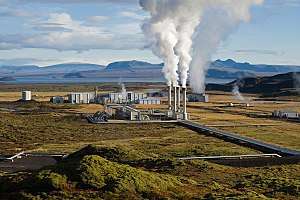
Global geothermal capacity in 2017 was 12.9 GW.[15]
High temperature geothermal energy is from thermal energy generated and stored in the Earth. Thermal energy is the energy that determines the temperature of matter. Earth's geothermal energy originates from the original formation of the planet and from radioactive decay of minerals (in currently uncertain[65] but possibly roughly equal[66] proportions). The geothermal gradient, which is the difference in temperature between the core of the planet and its surface, drives a continuous conduction of thermal energy in the form of heat from the core to the surface. The adjective geothermal originates from the Greek roots geo, meaning earth, and thermos, meaning heat.
The heat that is used for geothermal energy can be from deep within the Earth, all the way down to Earth's core – 4,000 miles (6,400 km) down. At the core, temperatures may reach over 9,000 °F (5,000 °C). Heat conducts from the core to surrounding rock. Extremely high temperature and pressure cause some rock to melt, which is commonly known as magma. Magma convects upward since it is lighter than the solid rock. This magma then heats rock and water in the crust, sometimes up to 700 °F (371 °C).[67]
Low temperature geothermal[35] refers to the use of the outer crust of the Earth as a thermal battery to facilitate renewable thermal energy for heating and cooling buildings, and other refrigeration and industrial uses. In this form of geothermal, a geothermal heat pump and ground-coupled heat exchanger are used together to move heat energy into the Earth (for cooling) and out of the Earth (for heating) on a varying seasonal basis. Low temperature geothermal (generally referred to as "GHP") is an increasingly important renewable technology because it both reduces total annual energy loads associated with heating and cooling, and it also flattens the electric demand curve eliminating the extreme summer and winter peak electric supply requirements. Thus low temperature geothermal/GHP is becoming an increasing national priority with multiple tax credit support[68] and focus as part of the ongoing movement toward net zero energy.[36]
Bioenergy
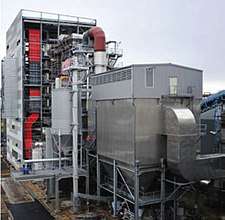
Bioenergy global capacity in 2017 was 109 GW.[15]
Biomass is biological material derived from living, or recently living organisms. It most often refers to plants or plant-derived materials which are specifically called lignocellulosic biomass.[69] As an energy source, biomass can either be used directly via combustion to produce heat, or indirectly after converting it to various forms of biofuel. Conversion of biomass to biofuel can be achieved by different methods which are broadly classified into: thermal, chemical, and biochemical methods. Wood remains the largest biomass energy source today;[70] examples include forest residues – such as dead trees, branches and tree stumps –, yard clippings, wood chips and even municipal solid waste. In the second sense, biomass includes plant or animal matter that can be converted into fibers or other industrial chemicals, including biofuels. Industrial biomass can be grown from numerous types of plants, including miscanthus, switchgrass, hemp, corn, poplar, willow, sorghum, sugarcane, bamboo,[71] and a variety of tree species, ranging from eucalyptus to oil palm (palm oil).
Plant energy is produced by crops specifically grown for use as fuel that offer high biomass output per hectare with low input energy.[72] The grain can be used for liquid transportation fuels while the straw can be burned to produce heat or electricity. Plant biomass can also be degraded from cellulose to glucose through a series of chemical treatments, and the resulting sugar can then be used as a first generation biofuel.
Biomass can be converted to other usable forms of energy such as methane gas[73] or transportation fuels such as ethanol and biodiesel. Rotting garbage, and agricultural and human waste, all release methane gas – also called landfill gas or biogas. Crops, such as corn and sugarcane, can be fermented to produce the transportation fuel, ethanol. Biodiesel, another transportation fuel, can be produced from left-over food products such as vegetable oils and animal fats.[74] Also, biomass to liquids (BTLs) and cellulosic ethanol are still under research.[75][76] There is a great deal of research involving algal fuel or algae-derived biomass due to the fact that it is a non-food resource and can be produced at rates 5 to 10 times those of other types of land-based agriculture, such as corn and soy. Once harvested, it can be fermented to produce biofuels such as ethanol, butanol, and methane, as well as biodiesel and hydrogen. The biomass used for electricity generation varies by region. Forest by-products, such as wood residues, are common in the United States. Agricultural waste is common in Mauritius (sugar cane residue) and Southeast Asia (rice husks). Animal husbandry residues, such as poultry litter, are common in the United Kingdom.[77]
Biofuels include a wide range of fuels which are derived from biomass. The term covers solid, liquid, and gaseous fuels.[78] Liquid biofuels include bioalcohols, such as bioethanol, and oils, such as biodiesel. Gaseous biofuels include biogas, landfill gas and synthetic gas. Bioethanol is an alcohol made by fermenting the sugar components of plant materials and it is made mostly from sugar and starch crops. These include maize, sugarcane and, more recently, sweet sorghum. The latter crop is particularly suitable for growing in dryland conditions, and is being investigated by International Crops Research Institute for the Semi-Arid Tropics for its potential to provide fuel, along with food and animal feed, in arid parts of Asia and Africa.[79]
With advanced technology being developed, cellulosic biomass, such as trees and grasses, are also used as feedstocks for ethanol production. Ethanol can be used as a fuel for vehicles in its pure form, but it is usually used as a gasoline additive to increase octane and improve vehicle emissions. Bioethanol is widely used in the United States and in Brazil. The energy costs for producing bio-ethanol are almost equal to, the energy yields from bio-ethanol. However, according to the European Environment Agency, biofuels do not address global warming concerns.[80] Biodiesel is made from vegetable oils, animal fats or recycled greases. It can be used as a fuel for vehicles in its pure form, or more commonly as a diesel additive to reduce levels of particulates, carbon monoxide, and hydrocarbons from diesel-powered vehicles. Biodiesel is produced from oils or fats using transesterification and is the most common biofuel in Europe. Biofuels provided 2.7% of the world's transport fuel in 2010.[81]
Biomass, biogas and biofuels are burned to produce heat/power and in doing so harm the environment. Pollutants such as sulphurous oxides (SOx), nitrous oxides (NOx), and particulate matter (PM) are produced from the combustion of biomass; the World Health Organisation estimates that 7 million premature deaths are caused each year by air pollution.[82] Biomass combustion is a major contributor.[82][83][84]
Integration into the energy system
Renewable energy production from some sources such as wind and solar is more variable and more geographically spread than technology based on fossil fuels and nuclear. While integrating it into the wider energy system is feasible, it does lead to some additional challenges. In order for the energy system to remain stable, a set of measurements can be taken. Implementation of energy storage, using a wide variety of renewable energy technologies, and implementing a smart grid in which energy is automatically used at the moment it is produced can reduce risks and costs of renewable energy implementation.[85] In some locations, individual households can opt to purchase renewable energy through a consumer green energy program.
Electrical energy storage
Electrical energy storage is a collection of methods used to store electrical energy. Electrical energy is stored during times when production (especially from intermittent sources such as wind power, tidal power, solar power) exceeds consumption, and returned to the grid when production falls below consumption. Pumped-storage hydroelectricity accounts for more than 90% of all grid power storage. Costs of lithium-ion batteries are dropping rapidly, and are increasingly being deployed grid ancillary services and for domestic storage.
Market and industry trends
Renewable power has been more effective in creating jobs than coal or oil in the United States.[86] In 2016, employment in the sector increased 6 percent in the United States, causing employment in the non-renewable energy sector to decrease 18 percent. Worldwide, renewables employ about 8.1 million as of 2016.[87]
Growth of renewables
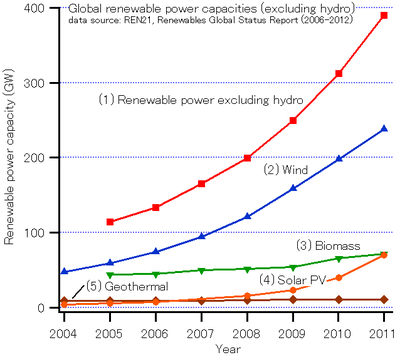
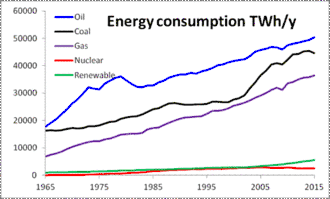
From the end of 2004, worldwide renewable energy capacity grew at rates of 10–60% annually for many technologies. In 2015 global investment in renewables rose 5% to $285.9 billion, breaking the previous record of $278.5 billion in 2011. 2015 was also the first year that saw renewables, excluding large hydro, account for the majority of all new power capacity (134 GW, making up 53.6% of the total). Of the renewables total, wind accounted for 72 GW and solar photovoltaics 56 GW; both record-breaking numbers and sharply up from 2014 figures (49 GW and 45 GW respectively). In financial terms, solar made up 56% of total new investment and wind accounted for 38%.
In 2014 global wind power capacity expanded 16% to 369,553 MW.[90] Yearly wind energy production is also growing rapidly and has reached around 4% of worldwide electricity usage,[91] 11.4% in the EU,[92] and it is widely used in Asia, and the United States. In 2015, worldwide installed photovoltaics capacity increased to 227 gigawatts (GW), sufficient to supply 1 percent of global electricity demands.[93] Solar thermal energy stations operate in the United States and Spain, and as of 2016, the largest of these is the 392 MW Ivanpah Solar Electric Generating System in California.[94][95] The world's largest geothermal power installation is The Geysers in California, with a rated capacity of 750 MW. Brazil has one of the largest renewable energy programs in the world, involving production of ethanol fuel from sugar cane, and ethanol now provides 18% of the country's automotive fuel. Ethanol fuel is also widely available in the United States.
In 2017, investments in renewable energy amounted to US$279.8 billion worldwide, with China accounting for US$126.6 billion or 45% of the global investments, the US for US$40.5 billion, and Europe for US$40.9 billion.[6] The results of a recent review of the literature concluded that as greenhouse gas (GHG) emitters begin to be held liable for damages resulting from GHG emissions resulting in climate change, a high value for liability mitigation would provide powerful incentives for deployment of renewable energy technologies.[96]
| Selected renewable energy global indicators | 2008 | 2009 | 2010 | 2011 | 2012 | 2013 | 2014 | 2015 | 2016 |
|---|---|---|---|---|---|---|---|---|---|
| Investment in new renewable capacity (annual) (109 USD)[97] | 182 | 178 | 237 | 279 | 256 | 232 | 270 | 285 | 241 |
| Renewables power capacity (existing) (GWe) | 1,140 | 1,230 | 1,320 | 1,360 | 1,470 | 1,578 | 1,712 | 1,849 | 2,017 |
| Hydropower capacity (existing) (GWe) | 885 | 915 | 945 | 970 | 990 | 1,018 | 1,055 | 1,064 | 1,096 |
| Wind power capacity (existing) (GWe) | 121 | 159 | 198 | 238 | 283 | 319 | 370 | 433 | 487 |
| Solar PV capacity (grid-connected) (GWe) | 16 | 23 | 40 | 70 | 100 | 138 | 177 | 227 | 303 |
| Solar hot water capacity (existing) (GWth) | 130 | 160 | 185 | 232 | 255 | 373 | 406 | 435 | 456 |
| Ethanol production (annual) (109 litres) | 67 | 76 | 86 | 86 | 83 | 87 | 94 | 98 | 98.6 |
| Biodiesel production (annual) (109 litres) | 12 | 17.8 | 18.5 | 21.4 | 22.5 | 26 | 29.7 | 30 | 30.8 |
| Countries with policy targets for renewable energy use | 79 | 89 | 98 | 118 | 138 | 144 | 164 | 173 | 176 |
| Source: The Renewable Energy Policy Network for the 21st Century (REN21)–Global Status Report[98][99][100][101][102][103] | |||||||||
Future projections
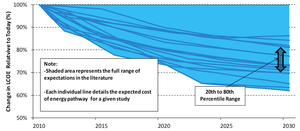
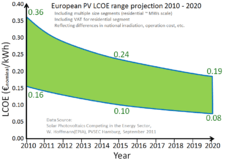
Renewable energy technologies are getting cheaper, through technological change and through the benefits of mass production and market competition. A 2018 report from the International Renewable Energy Agency (IRENA), found that the cost of renewable energy is quickly falling, and will likely be equal to or less than the cost non-renewables such as fossil fuels by 2020. The report found that solar power costs have dropped 73% since 2010 and onshore wind costs have dropped by 23% in that same timeframe.[106]
Current projections concerning the future cost of renewables vary however. The EIA has predicted that almost two thirds of net additions to power capacity will come from renewables by 2020 due to the combined policy benefits of local pollution, decarbonisation and energy diversification.
According to a 2018 report by Bloomberg New Energy Finance, wind and solar power are expected to generate roughly 50% of the world's energy needs by 2050, while coal powered electricity plants are expected to drop to just 11%.[107] Hydro-electricity and geothermal electricity produced at favourable sites are now the cheapest way to generate electricity. Renewable energy costs continue to drop, and the levelised cost of electricity (LCOE) is declining for wind power, solar photovoltaic (PV), concentrated solar power (CSP) and some biomass technologies.[108] Renewable energy is also the most economic solution for new grid-connected capacity in areas with good resources. As the cost of renewable power falls, the scope of economically viable applications increases. Renewable technologies are now often the most economic solution for new generating capacity. Where "oil-fired generation is the predominant power generation source (e.g. on islands, off-grid and in some countries) a lower-cost renewable solution almost always exists today".[108] A series of studies by the US National Renewable Energy Laboratory modeled the "grid in the Western US under a number of different scenarios where intermittent renewables accounted for 33 percent of the total power." In the models, inefficiencies in cycling the fossil fuel plants to compensate for the variation in solar and wind energy resulted in an additional cost of "between $0.47 and $1.28 to each MegaWatt hour generated"; however, the savings in the cost of the fuels saved "adds up to $7 billion, meaning the added costs are, at most, two percent of the savings."[109]
Trends for individual technologies
Hydroelectricity
In 2017 the world renewable hydropower capacity was 1,154 GW.[15] Only a quarter of the worlds estimated hydroelectric potential of 14,000 TWh/year has been developed, the regional potentials for the growth of hydropower around the world are, 71% Europe, 75% North America, 79% South America, 95% Africa, 95% Middle East, 82% Asia Pacific. However, the political realities of new reservoirs in western countries, economic limitations in the third world and the lack of a transmission system in undeveloped areas, result in the possibility of developing 25% of the remaining potential before 2050, with the bulk of that being in the Asia Pacific area.[110] There is slow growth taking place in Western counties, but not in the conventional dam and reservoir style of the past. New projects take the form of run-of-the-river and small hydro, neither using large reservoirs. It is popular to repower old dams thereby increasing their efficiency and capacity as well as quicker responsiveness on the grid.[111] Where circumstances permit existing dams such as the Russell Dam built in 1985 may be updated with "pump back" facilities for pumped-storage which is useful for peak loads or to support intermittent wind and solar power. Countries with large hydroelectric developments such as Canada and Norway are spending billions to expand their grids to trade with neighboring countries having limited hydro.[112]
Wind power development
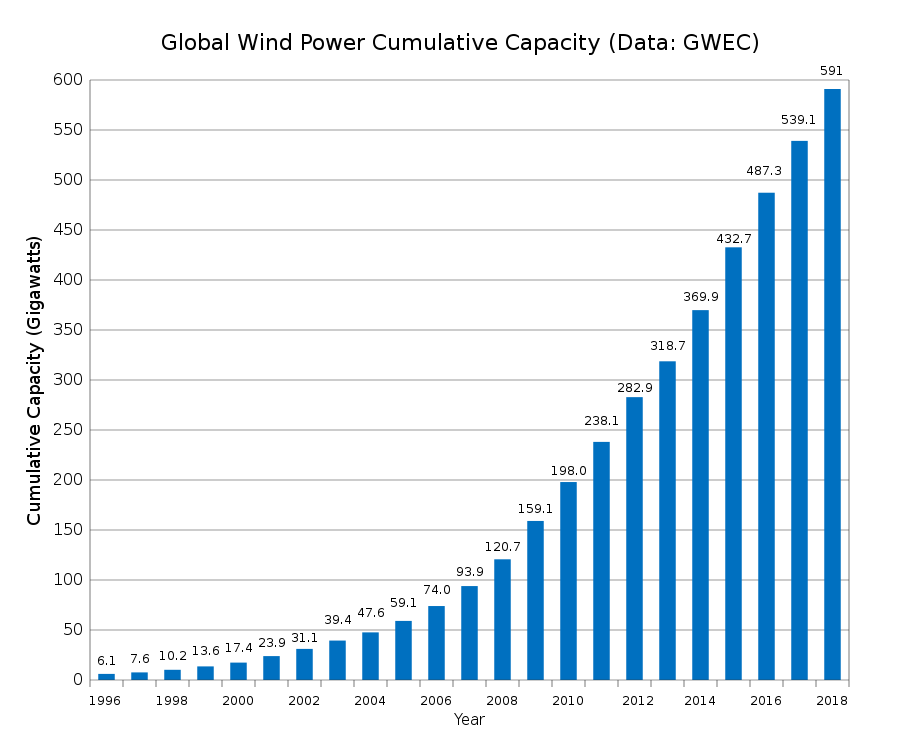
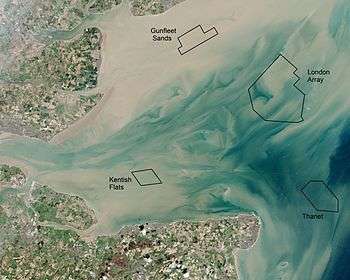
Wind power is widely used in Europe, China, and the United States. From 2004 to 2017, worldwide installed capacity of wind power has been growing from 47 GW to 514 GW—a more than tenfold increase within 13 years[15] As of the end of 2014, China, the United States and Germany combined accounted for half of total global capacity.[90] Several other countries have achieved relatively high levels of wind power penetration, such as 21% of stationary electricity production in Denmark, 18% in Portugal, 16% in Spain, and 14% in Ireland in 2010 and have since continued to expand their installed capacity.[113][114] More than 80 countries around the world are using wind power on a commercial basis.[81]
Wind turbines are increasing in power with some commercially deployed models generating over 8MW per turbine.[115][116][117] More powerful models are in development, see list of most powerful wind turbines.
- As of 2017, offshore wind power amounted to 18.7 GW of global installed capacity, accounting for only 3.6% of the total wind power capacity.[15]
- As of 2013, the Alta Wind Energy Center (California, 1.5 GW) is the world's largest single wind farm.[118] The Walney Extension (London, 0.7 GW) is the largest offshore wind farm in the world. Gansu Wind Farm (China, 7.9 GW) is the largest wind energy project generating project consisting of 18 wind farms.[119]
Solar thermal
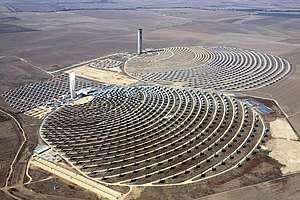
Solar thermal energy capacity has increased from 1.3 GW in 2012 to 5.0 GW in 2017.[15]
Spain is the world leader in solar thermal power deployment with 2.3 GW deployed.[15] The United States has 1.8 GW,[15] most of it in California where 1.4 GW of solar thermal power projects are operational.[120] Several power plants have been constructed in the Mojave Desert, Southwestern United States. As of 2017 only 4 other countries have deployments above 100 MW:[15] South Africa (300 MW) India (229 MW) Morocco (180 MW) and United Arab Emirates (100 MW).
The United States conducted much early research in photovoltaics and concentrated solar power. The U.S. is among the top countries in the world in electricity generated by the Sun and several of the world's largest utility-scale installations are located in the desert Southwest.
The oldest solar thermal power plant in the world is the 354 megawatt (MW) SEGS thermal power plant, in California.[121] The Ivanpah Solar Electric Generating System is a solar thermal power project in the California Mojave Desert, 40 miles (64 km) southwest of Las Vegas, with a gross capacity of 377 MW.[122] The 280 MW Solana Generating Station is a solar power plant near Gila Bend, Arizona, about 70 miles (110 km) southwest of Phoenix, completed in 2013. When commissioned it was the largest parabolic trough plant in the world and the first U.S. solar plant with molten salt thermal energy storage.[123]
In developing countries, three World Bank projects for integrated solar thermal/combined-cycle gas-turbine power plants in Egypt, Mexico, and Morocco have been approved.[124]
Photovoltaic development
Worldwide growth of PV capacity grouped by region in MW (2006–2014)
Photovoltaics (PV) is rapidly-growing with global capacity increasing from 177 GW at the end of 2014 to 385 GW in 2017.[15]
PV uses solar cells assembled into solar panels to convert sunlight into electricity. PV systems range from small, residential and commercial rooftop or building integrated installations, to large utility-scale photovoltaic power station. The predominant PV technology is crystalline silicon, while thin-film solar cell technology accounts for about 10 percent of global photovoltaic deployment. In recent years, PV technology has improved its electricity generating efficiency, reduced the installation cost per watt as well as its energy payback time, and reached grid parity in at least 30 different markets by 2014.[125] Building-integrated photovoltaics or "onsite" PV systems use existing land and structures and generate power close to where it is consumed.[126]
Photovoltaics grew fastest in China, followed by Japan and the United States. Italy meets 7.9 percent of its electricity demands with photovoltaic power—the highest share worldwide.[127] Solar power is forecasted to become the world's largest source of electricity by 2050, with solar photovoltaics and concentrated solar power contributing 16% and 11%, respectively. This requires an increase of installed PV capacity to 4,600 GW, of which more than half is expected to be deployed in China and India.[128]
_(2).jpg)
Commercial concentrated solar power plants were first developed in the 1980s. As the cost of solar electricity has fallen, the number of grid-connected solar PV systems has grown into the millions and utility-scale solar power stations with hundreds of megawatts are being built. Many solar photovoltaic power stations have been built, mainly in Europe, China and the United States.[129] The 1.5 GW Tengger Desert Solar Park, in China is the world's largest PV power station. Many of these plants are integrated with agriculture and some use tracking systems that follow the sun's daily path across the sky to generate more electricity than fixed-mounted systems.
Biofuel development

Bioenergy global capacity in 2017 was 109 GW.[15] Biofuels provided 3% of the world's transport fuel in 2017.[130]
Mandates for blending biofuels exist in 31 countries at the national level and in 29 states/provinces.[81] According to the International Energy Agency, biofuels have the potential to meet more than a quarter of world demand for transportation fuels by 2050.[131]
Since the 1970s, Brazil has had an ethanol fuel program which has allowed the country to become the world's second largest producer of ethanol (after the United States) and the world's largest exporter.[132] Brazil's ethanol fuel program uses modern equipment and cheap sugarcane as feedstock, and the residual cane-waste (bagasse) is used to produce heat and power.[133] There are no longer light vehicles in Brazil running on pure gasoline. By the end of 2008 there were 35,000 filling stations throughout Brazil with at least one ethanol pump.[134] Unfortunately, Operation Car Wash has seriously eroded public trust in oil companies and has implicated several high ranking Brazilian officials.
Nearly all the gasoline sold in the United States today is mixed with 10% ethanol,[135] and motor vehicle manufacturers already produce vehicles designed to run on much higher ethanol blends. Ford, Daimler AG, and GM are among the automobile companies that sell "flexible-fuel" cars, trucks, and minivans that can use gasoline and ethanol blends ranging from pure gasoline up to 85% ethanol. By mid-2006, there were approximately 6 million ethanol compatible vehicles on U.S. roads.[136]
Geothermal development
Global geothermal capacity in 2017 was 12.9 GW.[15]
Geothermal power is cost effective, reliable, sustainable, and environmentally friendly,[137] but has historically been limited to areas near tectonic plate boundaries. Recent technological advances have expanded the range and size of viable resources, especially for applications such as home heating, opening a potential for widespread exploitation. Geothermal wells release greenhouse gases trapped deep within the earth, but these emissions are usually much lower per energy unit than those of fossil fuels. As a result, geothermal power has the potential to help mitigate global warming if widely deployed in place of fossil fuels.
In 2017, the United States led the world in geothermal electricity production with 12.9 GW of installed capacity.[15] The largest group of geothermal power plants in the world is located at The Geysers, a geothermal field in California.[138] The Philippines follows the US as the second highest producer of geothermal power in the world, with 1.9 GW of capacity online.[15]
Developing countries

Renewable energy technology has sometimes been seen as a costly luxury item by critics, and affordable only in the affluent developed world. This erroneous view has persisted for many years, however between 2016 and 2017, investments in renewable energy were higher in developing countries than in developed countries, with China leading global investment with a record 126.6 billion dollars. Many Latin American and African countries increased their investments significantly as well.[139] Renewable energy can be particularly suitable for developing countries. In rural and remote areas, transmission and distribution of energy generated from fossil fuels can be difficult and expensive. Producing renewable energy locally can offer a viable alternative.[140]
Technology advances are opening up a huge new market for solar power: the approximately 1.3 billion people around the world who don't have access to grid electricity. Even though they are typically very poor, these people have to pay far more for lighting than people in rich countries because they use inefficient kerosene lamps. Solar power costs half as much as lighting with kerosene.[141] As of 2010, an estimated 3 million households get power from small solar PV systems.[142] Kenya is the world leader in the number of solar power systems installed per capita. More than 30,000 very small solar panels, each producing 1[143] 2 to 30 watts, are sold in Kenya annually. Some Small Island Developing States (SIDS) are also turning to solar power to reduce their costs and increase their sustainability.
Micro-hydro configured into mini-grids also provide power. Over 44 million households use biogas made in household-scale digesters for lighting and/or cooking, and more than 166 million households rely on a new generation of more-efficient biomass cookstoves.[31] Clean liquid fuel sourced from renewable feedstocks are used for cooking and lighting in energy-poor areas of the developing world. Alcohol fuels (ethanol and methanol) can be produced sustainably from non-food sugary, starchy, and cellulostic feedstocks. Project Gaia, Inc. and CleanStar Mozambique are implementing clean cooking programs with liquid ethanol stoves in Ethiopia, Kenya, Nigeria and Mozambique.[144]
Renewable energy projects in many developing countries have demonstrated that renewable energy can directly contribute to poverty reduction by providing the energy needed for creating businesses and employment. Renewable energy technologies can also make indirect contributions to alleviating poverty by providing energy for cooking, space heating, and lighting. Renewable energy can also contribute to education, by providing electricity to schools.[145]
Policy
Policies to support renewable energy have been vital in their expansion. Where Europe dominated in establishing energy policy in early 2000s, most countries around the world now have some form of energy policy.[146]
Policy trends
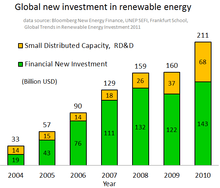
The International Renewable Energy Agency (IRENA) is an intergovernmental organization for promoting the adoption of renewable energy worldwide. It aims to provide concrete policy advice and facilitate capacity building and technology transfer. IRENA was formed in 2009, by 75 countries signing the charter of IRENA.[148] As of April 2019, IRENA has 160 member states.[149] The then United Nations' Secretary-General Ban Ki-moon has said that renewable energy has the ability to lift the poorest nations to new levels of prosperity,[32] and in September 2011 he launched the UN Sustainable Energy for All initiative to improve energy access, efficiency and the deployment of renewable energy.[150]
The 2015 Paris Agreement on climate change motivated many countries to develop or improve renewable energy policies.[12] In 2017, a total of 121 countries have adapted some form of renewable energy policy.[146] National targets that year existed in at 176 countries.[12] In addition, there is also a wide range of policies at state/provincial and local levels.[81] Some public utilities help plan or install residential energy upgrades. Under president Barack Obama, the United States policy encouraged the uptake of renewable energy in line with commitments to the Paris agreement. Even though Trump has abandoned these goals, renewable investment is still on the rise.[151]
Many national, state, and local governments have created green banks. A green bank is a quasi-public financial institution that uses public capital to leverage private investment in clean energy technologies.[152] Green banks use a variety of financial tools to bridge market gaps that hinder the deployment of clean energy. The US military has also focused on the use of renewable fuels for military vehicles. Unlike fossil fuels, renewable fuels can be produced in any country, creating a strategic advantage. The US military has already committed itself to have 50% of its energy consumption come from alternative sources.[153]
100% renewable energy
The incentive to use 100% renewable energy, for electricity, transport, or even total primary energy supply globally, has been motivated by global warming and other ecological as well as economic concerns. The Intergovernmental Panel on Climate Change has said that there are few fundamental technological limits to integrating a portfolio of renewable energy technologies to meet most of total global energy demand. Renewable energy use has grown much faster than even advocates anticipated.[154] At the national level, at least 30 nations around the world already have renewable energy contributing more than 20% of energy supply. Also, Professors S. Pacala and Robert H. Socolow have developed a series of "stabilization wedges" that can allow us to maintain our quality of life while avoiding catastrophic climate change, and "renewable energy sources," in aggregate, constitute the largest number of their "wedges".[155]
Using 100% renewable energy was first suggested in a Science paper published in 1975 by Danish physicist Bent Sørensen.[156] It was followed by several other proposals, until in 1998 the first detailed analysis of scenarios with very high shares of renewables were published. These were followed by the first detailed 100% scenarios. In 2006 a PhD thesis was published by Czisch in which it was shown that in a 100% renewable scenario energy supply could match demand in every hour of the year in Europe and North Africa. In the same year Danish Energy professor Henrik Lund published a first paper[157] in which he addresses the optimal combination of renewables, which was followed by several other papers on the transition to 100% renewable energy in Denmark. Since then Lund has been publishing several papers on 100% renewable energy. After 2009 publications began to rise steeply, covering 100% scenarios for countries in Europe, America, Australia and other parts of the world.[158]
In 2011 Mark Z. Jacobson, professor of civil and environmental engineering at Stanford University, and Mark Delucchi published a study on 100% renewable global energy supply in the journal Energy Policy. They found producing all new energy with wind power, solar power, and hydropower by 2030 is feasible and existing energy supply arrangements could be replaced by 2050. Barriers to implementing the renewable energy plan are seen to be "primarily social and political, not technological or economic".[159] They also found that energy costs with a wind, solar, water system should be similar to today's energy costs.[160]
Similarly, in the United States, the independent National Research Council has noted that "sufficient domestic renewable resources exist to allow renewable electricity to play a significant role in future electricity generation and thus help confront issues related to climate change, energy security, and the escalation of energy costs … Renewable energy is an attractive option because renewable resources available in the United States, taken collectively, can supply significantly greater amounts of electricity than the total current or projected domestic demand."[161]
The most significant barriers to the widespread implementation of large-scale renewable energy and low carbon energy strategies are primarily political and not technological.[162][163] According to the 2013 Post Carbon Pathways report, which reviewed many international studies, the key roadblocks are: climate change denial, the fossil fuels lobby, political inaction, unsustainable energy consumption, outdated energy infrastructure, and financial constraints.[164]
According to World Bank the "below 2°C" climate scenario requires 3 billions of tonnes of metals and minerals by 2050. Supply of mined resources such as zinc, molybdenum, silver, nickel, copper must increase by up to 500%.[165] A 2018 analysis estimated required increases in stock of metals required by various sectors from 1000% (wind power) to 87'000% (personal vehicle batteries).[166]
Emerging technologies
Other renewable energy technologies are still under development, and include cellulosic ethanol, hot-dry-rock geothermal power, and marine energy.[167] These technologies are not yet widely demonstrated or have limited commercialization. Many are on the horizon and may have potential comparable to other renewable energy technologies, but still depend on attracting sufficient attention and research, development and demonstration (RD&D) funding.[167]
There are numerous organizations within the academic, federal, and commercial sectors conducting large scale advanced research in the field of renewable energy. This research spans several areas of focus across the renewable energy spectrum. Most of the research is targeted at improving efficiency and increasing overall energy yields.[168] Multiple federally supported research organizations have focused on renewable energy in recent years. Two of the most prominent of these labs are Sandia National Laboratories and the National Renewable Energy Laboratory (NREL), both of which are funded by the United States Department of Energy and supported by various corporate partners.[169] Sandia has a total budget of $2.4 billion[170] while NREL has a budget of $375 million.[171]
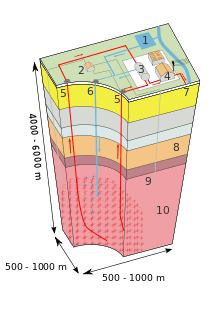
- Enhanced geothermal systems (EGS) are a new type of geothermal power technologies that do not require natural convective hydrothermal resources. The vast majority of geothermal energy within drilling reach is in dry and non-porous rock.[172] EGS technologies "enhance" and/or create geothermal resources in this "hot dry rock (HDR)" through hydraulic fracturing. EGS and HDR technologies, such as hydrothermal geothermal, are expected to be baseload resources which produce power 24 hours a day like a fossil plant. Distinct from hydrothermal, HDR and EGS may be feasible anywhere in the world, depending on the economic limits of drill depth. Good locations are over deep granite covered by a thick (3–5 km) layer of insulating sediments which slow heat loss.[173] There are HDR and EGS systems currently being developed and tested in France, Australia, Japan, Germany, the U.S. and Switzerland. The largest EGS project in the world is a 25 megawatt demonstration plant currently being developed in the Cooper Basin, Australia. The Cooper Basin has the potential to generate 5,000–10,000 MW.
- Several refineries that can process biomass and turn it into ethanol are built by companies such as Iogen, POET, and Abengoa, while other companies such as the Verenium Corporation, Novozymes, and Dyadic International[174] are producing enzymes which could enable future commercialization. The shift from food crop feedstocks to waste residues and native grasses offers significant opportunities for a range of players, from farmers to biotechnology firms, and from project developers to investors.[175]
- Marine energy (also sometimes referred to as ocean energy) refers to the energy carried by ocean waves, tides, salinity, and ocean temperature differences. The movement of water in the world's oceans creates a vast store of kinetic energy, or energy in motion. This energy can be harnessed to generate electricity to power homes, transport and industries. The term marine energy encompasses both wave power – power from surface waves, and tidal power – obtained from the kinetic energy of large bodies of moving water. Reverse electrodialysis (RED) is a technology for generating electricity by mixing fresh river water and salty sea water in large power cells designed for this purpose; as of 2016 it is being tested at a small scale (50 kW). Offshore wind power is not a form of marine energy, as wind power is derived from the wind, even if the wind turbines are placed over water. The oceans have a tremendous amount of energy and are close to many if not most concentrated populations. Ocean energy has the potential of providing a substantial amount of new renewable energy around the world.[176]
| # | Station | Country | Location | Capacity | Refs |
|---|---|---|---|---|---|
| 1. | Sihwa Lake Tidal Power Station | South Korea | 37°18′47″N 126°36′46″E | 254 MW | [177] |
| 2. | Rance Tidal Power Station | France | 48°37′05″N 02°01′24″W | 240 MW | [178] |
| 3. | Annapolis Royal Generating Station | Canada | 44°45′07″N 65°30′40″W | 20 MW | [178] |
- Concentrated photovoltaics (CPV) systems employ sunlight concentrated onto photovoltaic surfaces for the purpose of electricity generation. Thermoelectric, or "thermovoltaic" devices convert a temperature difference between dissimilar materials into an electric current.
- Floating solar arrays
- Floating solar arrays are PV systems that float on the surface of drinking water reservoirs, quarry lakes, irrigation canals or remediation and tailing ponds. A small number of such systems exist in France, India, Japan, South Korea, the United Kingdom, Singapore and the United States.[179][180][181][182][183] The systems are said to have advantages over photovoltaics on land. The cost of land is more expensive, and there are fewer rules and regulations for structures built on bodies of water not used for recreation. Unlike most land-based solar plants, floating arrays can be unobtrusive because they are hidden from public view. They achieve higher efficiencies than PV panels on land, because water cools the panels. The panels have a special coating to prevent rust or corrosion.[184] In May 2008, the Far Niente Winery in Oakville, California, pioneered the world's first floatovoltaic system by installing 994 solar PV modules with a total capacity of 477 kW onto 130 pontoons and floating them on the winery's irrigation pond.[185] Utility-scale floating PV farms are starting to be built. Kyocera will develop the world's largest, a 13.4 MW farm on the reservoir above Yamakura Dam in Chiba Prefecture[186] using 50,000 solar panels.[187][188] Salt-water resistant floating farms are also being constructed for ocean use.[189] The largest so far announced floatovoltaic project is a 350 MW power station in the Amazon region of Brazil.[190]
- A heat pump is a device that provides heat energy from a source of heat to a destination called a "heat sink". Heat pumps are designed to move thermal energy opposite to the direction of spontaneous heat flow by absorbing heat from a cold space and releasing it to a warmer one. A solar-assisted heat pump represents the integration of a heat pump and thermal solar panels in a single integrated system. Typically these two technologies are used separately (or only placing them in parallel) to produce hot water.[191] In this system the solar thermal panel performs the function of the low temperature heat source and the heat produced is used to feed the heat pump's evaporator.[192] The goal of this system is to get high COP and then produce energy in a more efficient and less expensive way.
- It is possible to use any type of solar thermal panel (sheet and tubes, roll-bond, heat pipe, thermal plates) or hybrid (mono/polycrystalline, thin film) in combination with the heat pump. The use of a hybrid panel is preferable because it allows covering a part of the electricity demand of the heat pump and reduce the power consumption and consequently the variable costs of the system.
- Artificial photosynthesis uses techniques including nanotechnology to store solar electromagnetic energy in chemical bonds by splitting water to produce hydrogen and then using carbon dioxide to make methanol.[193] Researchers in this field are striving to design molecular mimics of photosynthesis which use a wider region of the solar spectrum, employ catalytic systems made from abundant, inexpensive materials that are robust, readily repaired, non-toxic, stable in a variety of environmental conditions and perform more efficiently allowing a greater proportion of photon energy to end up in the storage compounds, i.e., carbohydrates (rather than building and sustaining living cells).[194] However, prominent research faces hurdles, Sun Catalytix a MIT spin-off stopped scaling up their prototype fuel-cell in 2012, because it offers few savings over other ways to make hydrogen from sunlight.[195]
- Algae fuels
- Producing liquid fuels from oil-rich varieties of algae is an ongoing research topic. Various microalgae grown in open or closed systems are being tried including some system that can be set up in brownfield and desert lands.
- Solar aircraft
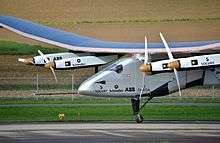
- An electric aircraft is an aircraft that runs on electric motors rather than internal combustion engines, with electricity coming from fuel cells, solar cells, ultracapacitors, power beaming,[196] or batteries.
- Currently, flying manned electric aircraft are mostly experimental demonstrators, though many small unmanned aerial vehicles are powered by batteries. Electrically powered model aircraft have been flown since the 1970s, with one report in 1957.[197][198] The first man-carrying electrically powered flights were made in 1973.[199] Between 2015–2016, a manned, solar-powered plane, Solar Impulse 2, completed a circumnavigation of the Earth.[200]
- The Solar updraft tower is a renewable-energy power plant for generating electricity from low temperature solar heat. Sunshine heats the air beneath a very wide greenhouse-like roofed collector structure surrounding the central base of a very tall chimney tower. The resulting convection causes a hot air updraft in the tower by the chimney effect. This airflow drives wind turbines placed in the chimney updraft or around the chimney base to produce electricity. Plans for scaled-up versions of demonstration models will allow significant power generation, and may allow development of other applications, such as water extraction or distillation, and agriculture or horticulture. A more advanced version of a similarly themed technology is the Vortex engine which aims to replace large physical chimneys with a vortex of air created by a shorter, less-expensive structure.
- For either photovoltaic or thermal systems, one option is to loft them into space, particularly Geosynchronous orbit. To be competitive with Earth-based solar power systems, the specific mass (kg/kW) times the cost to loft mass plus the cost of the parts needs to be $2400 or less. I.e., for a parts cost plus rectenna of $1100/kW, the product of the $/kg and kg/kW must be $1300/kW or less.[201] Thus for 6.5 kg/kW, the transport cost cannot exceed $200/kg. While that will require a 100 to one reduction, SpaceX is targeting a ten to one reduction, Reaction Engines may make a 100 to one reduction possible.
- Water vapor
Collection of static electricity charges from water droplets on metal surfaces is an experimental technology that would be especially useful in low-income countries with relative air humidity over 60%.[202]
Debate
Renewable electricity production, from sources such as wind power and solar power, is variable which results in reduced capacity factor and require either energy storage of capacity equal to its total output, or base load power sources from non intermittent sources like hydropower, fossil fuels or nuclear power.
Since renewable energy sources power density per land area is at best three orders of magnitude smaller than fossil or nuclear power,[203] renewable power plants tends to occupy thousands of hectares causing environmental concerns and opposition from local residents, especially in densely populated countries. Solar power plants are competing with arable land and nature reserves,[204] while on-shore wind farms face opposition due to aesthetic concerns and noise, which is impacting both humans and wildlife.[205][206][207][208] In the United States, the Massachusetts Cape Wind project was delayed for years partly because of aesthetic concerns. However, residents in other areas have been more positive. According to a town councilor, the overwhelming majority of locals believe that the Ardrossan Wind Farm in Scotland has enhanced the area.[209] These concerns, when directed against renewable energy, are sometimes described as "not in my back yard" attitude (NIMBY).
A recent UK Government document states that "projects are generally more likely to succeed if they have broad public support and the consent of local communities. This means giving communities both a say and a stake".[210] In countries such as Germany and Denmark many renewable projects are owned by communities, particularly through cooperative structures, and contribute significantly to overall levels of renewable energy deployment.[211][212]
The market for renewable energy technologies has continued to grow. Climate change concerns and increasing in green jobs, coupled with high oil prices, peak oil, oil wars, oil spills, promotion of electric vehicles and renewable electricity, nuclear disasters and increasing government support, are driving increasing renewable energy legislation, incentives and commercialization.[18] New government spending, regulation and policies helped the industry weather the 2009 economic crisis better than many other sectors.[29]
While renewables have been very successful in their ever-growing contribution to electrical power there are no countries dominated by fossil fuels who have a plan to stop and get that power from renwables. Only Scotland and Ontario have stopped burning coal, largely due to good natural gas supplies. In the area of transportation, fossil fuels are even more entrenched and solutions harder to find.[213] It's unclear if there are failures with policy or renewable energy, but twenty years after the Kyoto Protocol fossil fuels are still our primary energy source and consumption continues to grow.[214]
The International Energy Agency has stated that deployment of renewable technologies usually increases the diversity of electricity sources and, through local generation, contributes to the flexibility of the system and its resistance to central shocks.[215]
Geopolitics of renewable energy
From around 2010 onwards, there was increasing discussion about the geopolitical impact of the growing use of renewable energy.[216] It was argued that former fossil fuels exporters would experience a weakening of their position in international affairs, while countries with abundant sunshine, wind, hydropower, or geothermal resources would be strengthened.[217] Also countries rich in critical materials for renewable energy technologies were expected to rise in importance in international affairs.[218]
The GeGaLo index of geopolitical gains and losses assesses how the geopolitical position of 156 countries may change if the world fully transitions to renewable energy resources. Former fossil fuels exporters are expected to lose power, while the positions of former fossil fuel importers and countries rich in renewable energy resources is expected to strengthen.[219]
Environmental impact
The ability of biomass and biofuels to contribute to a reduction in CO
2 emissions is limited because both biomass and biofuels emit large amounts of air pollution when burned and in some cases compete with food supply. Furthermore, biomass and biofuels consume large amounts of water.[220] Other renewable sources such as wind power, photovoltaics, and hydroelectricity have the advantage of being able to conserve water, lower pollution and reduce CO
2 emissions.
The installations used to produce wind, solar and hydro power are an increasing threat to key conservation areas, with facilities built in areas set aside for nature conservation and other environmentally sensitive areas. They are often much larger than fossil fuel power plants, needing areas of land up to 10 times greater than coal or gas to produce equivalent energy amounts.[221] More than 2000 renewable energy facilities are built, and more are under construction, in areas of environmental importance and threaten the habitats of plant and animal species across the globe. The authors' team emphazised that their work should not be interpreted as anti-renewables because renewable energy is crucial for reducing carbon emissions. The key is ensuring that renewable energy facilities are built in places where they do not damage biodiversity.[222]
Renewable energy devices depend on non-renewable resources such as mined metals and use vast amounts of land due to their small surface power density. Manufacturing of photovoltaic panels, wind turbines and batteries requires significant amounts of rare-earth elements[223] and increases mining operations, which have social and environmental impact.[224] Due to co-occurrence of rare-earth and radioactive elements (thorium, uranium and radium), rare-earth mining results in production of low-level radioactive waste.[225]
Solar panels change the albedo of the surface what increases their contribution to global warming.[226]
Gallery
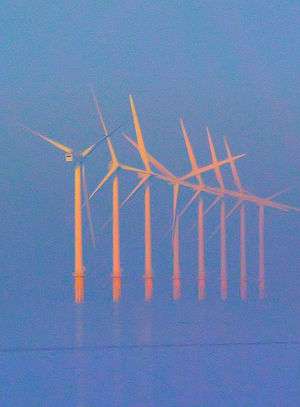
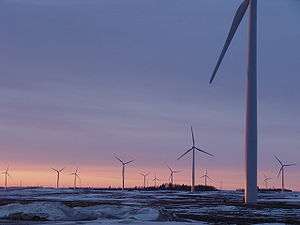 Sunrise at the Fenton Wind Farm in Minnesota, US
Sunrise at the Fenton Wind Farm in Minnesota, US- Ivanpah solar plant in the Mojave Desert, California, United States
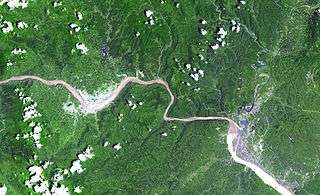 Three Gorges Dam and Gezhouba Dam, China
Three Gorges Dam and Gezhouba Dam, China- Stump harvesting increases recovery of biomass from forests
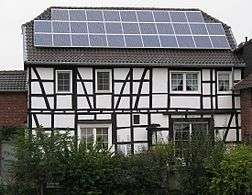 A small, roof-top mounted PV system in Bonn, Germany
A small, roof-top mounted PV system in Bonn, Germany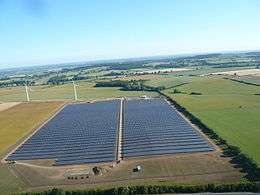 The community-owned Westmill Solar Park in South East England
The community-owned Westmill Solar Park in South East England- Komekurayama photovoltaic power station in Kofu, Japan
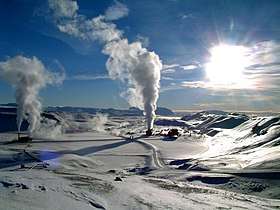 Krafla, a geothermal power station in Iceland
Krafla, a geothermal power station in Iceland
See also
- Distributed generation
- Efficient energy use
- Energy harvesting
- Energy storage
- Thermal energy storage
- Renewable energy by country
References
- "Electricity generation by source". International Energy Agency.
- "Types of renewable energy". Renewable Energy World. Retrieved 27 October 2019.
- Ellabban, Omar; Abu-Rub, Haitham; Blaabjerg, Frede (2014). "Renewable energy resources: Current status, future prospects and their enabling technology". Renewable and Sustainable Energy Reviews. 39: 748–764 [749]. doi:10.1016/j.rser.2014.07.113.
- "Renewables 2010 Global Status Report" (PDF). REN21. September 2010. Retrieved 27 October 2019.
- REN21, Global Status Report 2016. Retrieved 8 June 2016.
- Frankfurt School – UNEP Collaborating Centre for Climate & Sustainable Energy Finance (2018). Global Trends in Renewable Energy Investment 2018. Available online at: https://europa.eu/capacity4dev/unep/documents/global-trends-renewable-energy-investment-2018
- IRENA, Renewable energy and jobs, Annual review 2015, IRENA.
- "Global renewable energy trends". Deloitte Insights.
- "Renewable Energy Now Accounts for a Third of Global Power Capacity". IRENA. 2 April 2019. Archived from the original on 21 April 2019. Retrieved 21 April 2019.
- Electric cars and cheap solar 'could halt fossil fuel growth by 2020' The Guardian
- "Expect the Unexpected : The Disruptive Power of Low-carbon Technology" (PDF). Carbontracker.org. pp. 3, 30.
- REN21 (2017). "Renewables global futures report 2017".
- Vad Mathiesen, Brian; et al. (2015). "Smart Energy Systems for coherent 100% renewable energy and transport solutions". Applied Energy. 145: 139–154. doi:10.1016/j.apenergy.2015.01.075.
- "12 Countries Leading the Way in Renewable Energy". Click Energy.
- "Renewable Electricity Capacity And Generation Statistics June 2018". Archived from the original on 28 November 2018. Retrieved 27 November 2018.
- "Renewable Electricity Capacity And Generation Statistics June 2018". Retrieved 3 January 2019.
- International Energy Agency (2012). "Energy Technology Perspectives 2012" (PDF).
- "Global Trends in Sustainable Energy Investment 2007: Analysis of Trends and Issues in the Financing of Renewable Energy and Energy Efficiency in OECD and Developing Countries" (PDF). unep.org. United Nations Environment Programme. 2007. p. 3. Archived (PDF) from the original on 4 March 2016. Retrieved 13 October 2014.
- Sütterlin, B.; Siegrist, Michael (2017). "Public acceptance of renewable energy technologies from an abstract versus concrete perspective and the positive imagery of solar power". Energy Policy. 106: 356–366. doi:10.1016/j.enpol.2017.03.061.
- World Energy Assessment (2001). Renewable energy technologies Archived 9 June 2007 at the Wayback Machine, p. 221.
- Armaroli, Nicola; Balzani, Vincenzo (2011). "Towards an electricity-powered world". Energy and Environmental Science. 4 (9): 3193–3222. doi:10.1039/c1ee01249e.
- Armaroli, Nicola; Balzani, Vincenzo (2016). "Solar Electricity and Solar Fuels: Status and Perspectives in the Context of the Energy Transition". Chemistry – A European Journal. 22 (1): 32–57. doi:10.1002/chem.201503580. PMID 26584653.
- Volker Quaschning, Regenerative Energiesysteme. Technologie – Berechnung – Simulation. 8th. Edition. Hanser (Munich) 2013, p. 49.
- IEA Renewable Energy Working Party (2002). Renewable Energy... into the mainstream, p. 9.
- Jacobson, Mark Z.; et al. (2015). "100% clean and renewable wind, water, and sunlight (WWS) all-sector energy roadmaps for the 50 United States". Energy and Environmental Science. 8 (7): 2093–2117. doi:10.1039/C5EE01283J.
- Schröder, K.-P.; Smith, R.C. (2008). "Distant future of the Sun and Earth revisited". Monthly Notices of the Royal Astronomical Society. 386 (1): 155–163. arXiv:0801.4031. Bibcode:2008MNRAS.386..155S. doi:10.1111/j.1365-2966.2008.13022.x.CS1 maint: ref=harv (link)
- Palmer, J. (2008). "Hope dims that Earth will survive Sun's death". New Scientist. Retrieved 24 March 2008.
- Carrington, D. (21 February 2000). "Date set for desert Earth". BBC News. Retrieved 31 March 2007.
- Clean Edge (2009). Clean Energy Trends 2009 Archived 18 March 2009 at the Wayback Machine pp. 1–4.
- "Global energy transformation: A roadmap to 2050 (2019 edition)". Archived from the original on 18 April 2019. Retrieved 21 April 2019.
- REN21 (2011). "Renewables 2011: Global Status Report" (PDF). p. 14.
- Leone, Steve (25 August 2011). "U.N. Secretary-General: Renewables Can End Energy Poverty". Renewable Energy World.
- REN21. "Renewables 2016: Global Status Report" (PDF). Renewable Energy Policy Network. Retrieved 31 October 2016.
- "Fast Growth for Copper-Based Geothermal Heating & Cooling". Archived from the original on 26 April 2019. Retrieved 26 April 2019.
- "Geothermal Heat Pumps - Department of Energy". energy.gov.
- "Net Zero Foundation". netzerofoundation.org.
- K. Kris Hirst. "The Discovery of Fire". About.com. Retrieved 15 January 2013.
- "wind energy". The Encyclopedia of Alternative Energy and Sustainable Living. Retrieved 15 January 2013.
- "Project 2 template". faculty.fairfield.edu. Retrieved 17 January 2017.
- "The surprising history of sustainable energy". Sustainablehistory.wordpress.com. Archived from the original on 24 December 2014. Retrieved 1 November 2012.
- Werner von Siemens (1885). "On the electromotive action of illuminated selenium, discovered by Mr. Fritts, of New York". Van Nostrands Engineering Magazine. 32: 514–516.
- Weber suggests that the modern economic world will determine the lifestyle of everyone born into it "until the last hundredweight of fossil fuel is burned" (bis der letzte Zentner fossilen Brennstoffs verglüht ist).
- "Power from Sunshine": A Business History of Solar Energy 25 May 2012
- Hubbert, M. King (June 1956). "Nuclear Energy and the Fossil Fuels" (PDF). Shell Oil Company/American Petroleum Institute. Archived from the original (PDF) on 27 May 2008. Retrieved 10 November 2014.
- "History of PV Solar". Solarstartechnologies.com. Archived from the original on 6 December 2013. Retrieved 1 November 2012.
- "Global Wind Atlas".
- "Data and Statistics - IRENA REsource". resourceirena.irena.org. Archived from the original on 28 November 2017. Retrieved 8 April 2019.
- "Analysis of Wind Energy in the EU-25" (PDF). European Wind Energy Association. Retrieved 11 March 2007.
- Martin Kaltschmitt, Wolfgang Streicher, Andreas Wiese (eds.): Erneuerbare Energien. Systemtechnik, Wirtschaftlichkeit, Umweltaspekte. Springer, Berlin/Heidelberg 2013, p. 819.
- "Offshore stations experience mean wind speeds at 80 m that are 90% greater than over land on average." Evaluation of global wind power "Overall, the researchers calculated winds at 80 meters [300 feet] above sea level traveled over the ocean at approximately 8.6 meters per second and at nearly 4.5 meters per second over land [20 and 10 miles per hour, respectively]." Global Wind Map Shows Best Wind Farm Locations. Retrieved 30 January 2006.
- Moran, Emilio F.; Lopez, Maria Claudia; Moore, Nathan; Müller, Norbert; Hyndman, David W. (2018). "Sustainable hydropower in the 21st century". Proceedings of the National Academy of Sciences. 115 (47): 11891–11898. doi:10.1073/pnas.1809426115. ISSN 0027-8424. PMC 6255148. PMID 30397145.
- "DocHdl2OnPN-PRINTRDY-01tmpTarget" (PDF). Retrieved 26 March 2019.
- Afework, Bethel (3 September 2018). "Run-of-the-river hydroelectricity". Energy Education. Retrieved 27 April 2019.
- Institute, Worldwatch (January 2012). "Use and Capacity of Global Hydropower Increases". Archived from the original on 24 September 2014. Retrieved 18 January 2014.
- "How Does Ocean Wave Power Work?". Energy Informative. Retrieved 27 April 2019.
- Unwin, Jack (12 March 2019). "Top five trends in wave power". Retrieved 27 April 2019.
- "Global Solar Atlas".
- "Solar Energy Perspectives: Executive Summary" (PDF). International Energy Agency. 2011. Archived from the original (PDF) on 13 January 2012.
- "Solar Fuels and Artificial Photosynthesis". Royal Society of Chemistry. 2012. Retrieved 11 March 2013.
- "Energy Sources: Solar". Department of Energy. Retrieved 19 April 2011.
- NREL.gov U.S. Renewable Energy Technical Potentials: A GIS-Based Analysis, July 2013 :iv
- thinkprogress.org National Renewable Energy Laboratory: Solar Has The Most Potential Of Any Renewable Energy Source Archived 22 January 2015 at the Wayback Machine, 30 July 2013
- "The Italian Solar Renaissance". Enel Green Power. 22 June 2018. Archived from the original on 22 April 2019. Retrieved 22 April 2019.
- "Solar energy". IEA. Retrieved 22 April 2019.
- Dye, S. T. (2012). "Geoneutrinos and the radioactive power of the Earth". Reviews of Geophysics. 50 (3): 3. arXiv:1111.6099. Bibcode:2012RvGeo..50.3007D. doi:10.1029/2012rg000400.
- Gando, A.; Dwyer, D. A.; McKeown, R. D.; Zhang, C. (2011). "Partial radiogenic heat model for Earth revealed by geoneutrino measurements" (PDF). Nature Geoscience. 4 (9): 647–651. Bibcode:2011NatGe...4..647K. doi:10.1038/ngeo1205.
- Nemzer, J. "Geothermal heating and cooling". Archived from the original on 11 January 1998.
- "Database of State Incentives for Renewables & Efficiency® - DSIRE". DSIRE.
- Biomass Energy Center. Biomassenergycentre.org.uk. Retrieved on 28 February 2012.
- "Log In". online.wsj.com.
- T.A. Volk, L.P. Abrahamson (January 2000). "Developing a Willow Biomass Crop Enterprise for Bioenergy and Bioproducts in the United States". North East Regional Biomass Program. Retrieved 4 June 2015.CS1 maint: uses authors parameter (link)
- "Energy crops". crops are grown specifically for use as fuel. BIOMASS Energy Centre. Archived from the original on 10 March 2013. Retrieved 6 April 2013.
- Howard, Brian (28 January 2020). "Turning cow waste into clean power on a national scale". TheHill. Retrieved 30 January 2020.
- Energy Kids. Eia.doe.gov. Retrieved on 28 February 2012.
- "Fuel Ethanol Production: GSP Systems Biology Research". U.S. Department of Energy Office of Science. 19 April 2010. Archived from the original on 27 May 2010. Retrieved 2 August 2010.
- "Breaking the Biological Barriers to Cellulosic Ethanol: A Joint Research Agenda" (PDF). June 2006. Retrieved 2 August 2010.
- Frauke Urban and Tom Mitchell 2011. Climate change, disasters and electricity generation Archived 20 September 2012 at the Wayback Machine. London: Overseas Development Institute and Institute of Development Studies
- Demirbas, A. (2009). "Political, economic and environmental impacts of biofuels: A review". Applied Energy. 86: S108–S117. doi:10.1016/j.apenergy.2009.04.036.
- Sweet sorghum for food, feed and fuel Archived 4 September 2015 at the Wayback Machine New Agriculturalist, January 2008.
- "Opinion of the EEA Scientific Committee on Greenhouse Gas Accounting in Relation to Bioenergy". Retrieved 1 November 2012.
- REN21 (2011). "Renewables 2011: Global Status Report" (PDF). pp. 13–14. Archived from the original (PDF) on 13 May 2012.
- "WHO - 7 million premature deaths annually linked to air pollution".
- "WHO - Ambient (outdoor) air quality and health". Archived from the original on 4 January 2016.
- "WHO - Household air pollution and health". Who.int. Retrieved 26 March 2019.
- IPCC 2011, pp. 15–16
- Gunter, Linda Pentz. "Trump Is Foolish to Ignore the Flourishing Renewable Energy Sector". Truthout.
- "Renewable Energy Employs 8.1 Million People Worldwide". United Nations Framework Group on Climate Change. 26 May 2016. Retrieved 18 April 2019.
- "REN21, Renewables Global Status Report 2012" (PDF). Ren21.net. Archived from the original (PDF) on 26 June 2014. Retrieved 11 August 2014.
- Statistical Review of World Energy, Workbook (xlsx), London, 2016
- "GWEC Global Wind Statistics 2014" (PDF). GWEC. 10 February 2015.
- The World Wind Energy Association (2014). 2014 Half-year Report. WWEA. pp. 1–8.
- "Wind in power: 2015 European statistics- EWEA" (PDF).
- Hunt, Tam (9 March 2015). "The Solar Singularity Is Nigh". Greentech Media. Retrieved 29 April 2015.
- "World largest solar thermal plant syncs to the grid". Spectrum.ieee.org. Retrieved 28 November 2014.
- "World's Largest Solar Thermal Power Project at Ivanpah Achieves Commercial Operation" Archived 29 January 2016 at the Wayback Machine, NRG press release, 13 February 2014.
- Heidari, Negin; Pearce, Joshua M. (2016). "A Review of Greenhouse Gas Emission Liabilities as the Value of Renewable Energy for Mitigating Lawsuits for Climate Change Related Damages". Renewable and Sustainable Energy Reviews. 55C: 899–908. doi:10.1016/j.rser.2015.11.025.
- "Global New Investment in Renewable Energy..." (JPG). Ren21.net. Retrieved 26 March 2019.
- REN21 (2011). "Renewables 2011: Global Status Report" (PDF). p. 15.
- REN21 (2012). Renewables Global Status Report 2012 Archived 15 December 2012 at the Wayback Machine p. 17.
- "REN21 2013 Renewables Global Status Report" (PDF). Retrieved 30 January 2014.
- REN21. "Renewables 2014: Global Status Report" (PDF). Archived (PDF) from the original on 15 September 2014. Retrieved 20 January 2015.
- "RENEWABLES 2015 GLOBAL STATUS REPORT" (PDF). Ren21.net. Retrieved 26 March 2019.
- "REN21 2017 Renewables Global Status Report Highlights" (PDF). Retrieved 11 June 2017.
- E. Lantz, M. Hand, and R. Wiser ( 13–17 May 2012) "The Past and Future Cost of Wind Energy," National Renewable Energy Laboratory conference paper no. 6A20-54526, page 4
-
"Solar Photovoltaics Competing in the Energy Sector—On the road to competitiveness" (PDF). European Photovoltaic Industry Association. September 2011. p. 18. Archived from the original (PDF) on 26 February 2013.
Note: Germany already reached cost-range of €0.08–0.14/kWh in 2013.
- Dominic, Dominic (13 January 2018). "Renewable Energy Will Be Consistently Cheaper Than Fossil Fuels By 2020, Report Claims". Forbes. Retrieved 18 April 2019.
- "New Energy Outlook 2018". Bloomberg New Energy Finance. Bloomberg. Retrieved 18 April 2019.
- International Renewable Energy Agency (2012). "Renewable Power Generation Costs in 2012: An Overview" (PDF). irena.org.
- Timmer, John (25 September 2013). "Cost of renewable energy's variability is dwarfed by the savings: Wear and tear on equipment costs millions, but fuel savings are worth billions". Ars Technica. Condé Nast. Retrieved 26 September 2013.
- "Renewable Energy Essentials : Hydropower" (PDF). Iea.org. Archived from the original (PDF) on 29 March 2017. Retrieved 26 March 2019.
- L. Lia; T. Jensen; K.E. Stensbyand; G. Holm; A.M. Ruud. "The current status of hydropower development and dam construction in Norway" (PDF). Ntnu.no. Retrieved 26 March 2019.
- "New Transmission Line Reaches Milestone". Vpr.net.
- "World Wind Energy Report 2010" (PDF). Report. World Wind Energy Association. February 2011. Archived from the original (PDF) on 4 September 2011. Retrieved 30 April 2011.
- "Renewables". eirgrid.com. Archived from the original on 10 August 2011. Retrieved 22 November 2010.
- "European Offshore Wind Deployment Centre". 10 April 2018. Retrieved 23 September 2018.
- "World's Most Powerful Wind Turbine Installed". Retrieved 23 September 2018.
- "Dong vælger Vestas' supermølle". Retrieved 22 September 2018.
- Terra-Gen Closes on Financing for Phases VII and IX Archived 10 May 2012 at the Wayback Machine, Business Wire, 17 April 2012
- Vyas, Kashyap (15 February 2018). "The 11 Biggest Wind Farms and Wind Power Constructions That Reduce Carbon Footprint". Interesting Engineering. Retrieved 20 December 2018.
- "Solar Energy Projects in California". energy.ca.gov. Retrieved 3 January 2019.
- "Segs Iii, Iv, V, Vi, Vii, Viii & Ix". Fplenergy.com. Archived from the original on 5 August 2014. Retrieved 31 January 2012.
- "Brightsource Ivanpah". ivanpahsolar.com. Archived from the original on 11 January 2013. Retrieved 16 May 2014.
- Mearian, Lucas. U.S. flips switch on massive solar power array that also stores electricity: The array is first large U.S. solar plant with a thermal energy storage system, 10 October 2013. Retrieved 18 October 2013.
- REN21 (2008). Renewables 2007 Global Status Report (PDF) Archived 8 April 2008 at the Wayback Machine p. 12.
- "Crossing the Chasm" (PDF). Deutsche Bank Markets Research. 27 February 2015. Archived (PDF) from the original on 30 March 2015.
- "Solar Integrated in New Jersey". Jcwinnie.biz. Archived from the original on 19 July 2013. Retrieved 20 August 2013.
- "Snapshot of Global PV 1992-2014" (PDF). iea-pvps.org. International Energy Agency — Photovoltaic Power Systems Programme. 30 March 2015. Archived from the original on 7 April 2015.
- iea.org (2014). "Technology Roadmap: Solar Photovoltaic Energy" (PDF). IEA. Archived from the original (PDF) on 1 October 2014. Retrieved 7 October 2014.
- Denis Lenardic. Large-scale photovoltaic power plants ranking 1 - 50 Archived 1 January 2016 at the Wayback Machine PVresources.com, 2010.
- "Biofuels". www.iea.org. Retrieved 9 April 2019.
- "IEA says biofuels can displace 27% of transportation fuels by 2050 Washington". Platts. 20 April 2011.
- "Industry Statistics: Annual World Ethanol Production by Country". Renewable Fuels Association. Archived from the original on 8 April 2008. Retrieved 2 May 2008.
- Macedo Isaias, M. Lima Verde Leal and J. Azevedo Ramos da Silva (2004). "Assessment of greenhouse gas emissions in the production and use of fuel ethanol in Brazil" (PDF). Secretariat of the Environment, Government of the State of São Paulo. Archived from the original (PDF) on 28 May 2008. Retrieved 9 May 2008.
- Daniel Budny and Paulo Sotero, editor (April 2007). "Brazil Institute Special Report: The Global Dynamics of Biofuels" (PDF). Brazil Institute of the Woodrow Wilson Center. Archived from the original (PDF) on 28 May 2008. Retrieved 3 May 2008.
- Erica Gies. As Ethanol Booms, Critics Warn of Environmental Effect The New York Times, 24 June 2010.
- "American Energy: The Renewable Path to Energy Security" (PDF). Worldwatch Institute. September 2006. Retrieved 11 March 2007.
- William E. Glassley. Geothermal Energy: Renewable Energy and the Environment Archived 16 July 2011 at the Wayback Machine CRC Press, 2010.
- Khan, M. Ali (2007). "The Geysers Geothermal Field, an Injection Success Story" (PDF). Annual Forum of the Groundwater Protection Council. Archived from the original (PDF) on 26 July 2011. Retrieved 25 January 2010.
- Goodwin, Johnathan (27 August 2018). "The Developing World Is Taking Over Renewable Energy". Sustainable Brands. Retrieved 27 April 2019.
- Power for the People p. 3. Archived 30 March 2012 at the Wayback Machine
- Bullis, Kevin (27 January 2012). "In the Developing World, Solar Is Cheaper than Fossil Fuels". Technology Review.
- REN21 (2010). Renewables 2010 Global Status Report p. 12. Archived 13 May 2012 at the Wayback Machine
- Fry, Carolyn. 28 June 2012. Anguilla moves towards cleaner energy
- "Ethiopia". Projectgaia.com. Archived from the original on 11 November 2012. Retrieved 1 November 2012.
- Energy for Development: The Potential Role of Renewable Energy in Meeting the Millennium Development Goals Archived 27 May 2008 at the Wayback Machine pp. 7–9.
- "Policies". www.iea.org. Retrieved 8 April 2019.
- "Bloomberg New Energy Finance, UNEP SEFI, Frankfurt School, Global Trends in Renewable Energy Investment 2011". Unep.org. Retrieved 21 November 2011.
- Signatory States Archived 26 December 2010 at the Wayback Machine
- "IRENA Membership". /irenamembership. Archived from the original on 6 April 2019. Retrieved 8 April 2019.
- Tran, Mark (2 November 2011). "UN calls for universal access to renewable energy". The Guardian. London.
- McMahon, Jeff. "Despite Trump, U.S. Progressing Toward Obama's Climate Goals". Forbes. Retrieved 8 April 2019.
- Ken Berlin, Reed Hundt, Marko Muro, and Devashree Saha. "State Clean Energy Banks: New Investment Facilities for Clean Energy Deployment"
- Hooper, Craig (2011). "Air Force cedes the Green lead–and the lede–to Navy". nextnavy.com. Retrieved 27 December 2011.
- Gipe, Paul (4 April 2013). "100 Percent Renewable Vision Building". Renewable Energy World.
- S. Pacala & R. Socolow (2004). "Stabilization Wedges: Solving the Climate Problem for the Next 50 Years with Current Technologies" (PDF). Science. Science Vol. 305. 305 (5686): 968–972. Bibcode:2004Sci...305..968P. doi:10.1126/science.1100103. PMID 15310891.
- Sørensen, Bent (1975). "A plan is outlined according to which solar and wind energy would supply Denmark's needs by the year 2050". Science. 189 (4199): 255–260. Bibcode:1975Sci...189..255S. doi:10.1126/science.189.4199.255. PMID 17813696.
- Lund, Henrik (2006). "Large-scale integration of optimal combinations of PV, wind and wave power into the electricity supply". Renewable Energy. 31 (4): 503–515. doi:10.1016/j.renene.2005.04.008.
- Hohmeyer, Olav; Bohm, Sönke (2015). "Trends toward 100% renewable electricity supply in Germany and Europe: a paradigm shift in energy policies". Wiley Interdisciplinary Reviews: Energy and Environment. 4: 74–97. doi:10.1002/wene.128.
- "Mark Jacobson: Barriers to 100% Clean Energy are Social and Political, Not Technical or Economic". Eco Watch. 20 November 2015. Retrieved 10 May 2019.
- Mark A. Delucchi & Mark Z. Jacobson (2011). "Providing all global energy with wind, water, and solar power, Part II: Reliability, system and transmission costs, and policies" (PDF). Energy Policy. Elsevier Ltd. pp. 1170–1190.
- National Research Council (2010). Electricity from Renewable Resources: Status, Prospects, and Impediments. National Academies of Science. p. 4. doi:10.17226/12619. ISBN 978-0-309-13708-9.
- Jacobson, Mark Z.; Delucchi, Mark A.; Cameron, Mary A.; Coughlin, Stephen J.; Hay, Catherine A.; Manogaran, Indu Priya; Shu, Yanbo; Krauland, Anna-Katharina von (20 December 2019). "Impacts of Green New Deal Energy Plans on Grid Stability, Costs, Jobs, Health, and Climate in 143 Countries". One Earth. 1 (4): 449–463. Bibcode:2019AGUFMPA32A..01J. doi:10.1016/j.oneear.2019.12.003. ISSN 2590-3330.
- Koumoundouros, Tessa (27 December 2019). "Stanford Researchers Have an Exciting Plan to Tackle The Climate Emergency Worldwide". ScienceAlert. Retrieved 5 January 2020.
- Wiseman, John; et al. (April 2013). "Post Carbon Pathways" (PDF). University of Melbourne. Archived from the original (PDF) on 20 June 2014.
- Bromby, Robin (2 June 2020). "Needed by 2050: 3 billion tonnes of metals to generate clean energy". Small Caps. Retrieved 19 June 2020.
- Månberger, André; Stenqvist, Björn (1 August 2018). "Global metal flows in the renewable energy transition: Exploring the effects of substitutes, technological mix and development". Energy Policy. 119: 226–241. doi:10.1016/j.enpol.2018.04.056. ISSN 0301-4215.
- International Energy Agency (2007). Renewables in global energy supply: An IEA facts sheet (PDF), OECD, p. 3. Archived 12 October 2009 at the Wayback Machine
- S.C.E. Jupe; A. Michiorri; P.C. Taylor (2007). "Increasing the energy yield of generation from new and renewable energy sources". Renewable Energy. 14 (2): 37–62.
- "Defense-scale supercomputing comes to renewable energy research". Sandia National Laboratories. Retrieved 16 April 2012.
- "Sandia National Laboratories" (PDF). Sandia National Laboratories. Archived from the original (PDF) on 20 October 2011. Retrieved 16 April 2012.
-
- Chakrabarty, Gargi, 16 April 2009. "Stimulus leaves NREL in cold" Denver Post
- Duchane, Dave; Brown, Don (December 2002). "Hot Dry Rock (HDR) Geothermal Energy Research and Development at Fenton Hill, New Mexico" (PDF). Geo-Heat Centre Quarterly Bulletin. 23 (4). Klamath Falls, Oregon: Oregon Institute of Technology. pp. 13–19. ISSN 0276-1084. Retrieved 5 May 2009.
- "Australia's Renewable Energy Future inc Cooper Basin & geothermal map of Australia Retrieved 15 August 2015" (PDF). Archived from the original (PDF) on 27 March 2015.
- "Dyadic International - Bioenergy, Biopharmaceutical Enzymes".
- Pernick, Ron and Wilder, Clint (2007). The Clean Tech Revolution p. 96.
- Carbon Trust, Future Marine Energy. Results of the Marine Energy Challenge: Cost competitiveness and growth of wave and tidal stream energy, January 2006
- "Sihwa Tidal Power Plant". Renewable Energy News and Articles. Archived from the original on 4 September 2015.
- Tidal power (PDF), retrieved 20 March 2010
- "Kyocera, partners announce construction of the world's largest floating solar PV Plant in Hyogo prefecture, Japan". SolarServer.com. 4 September 2014. Archived from the original on 24 September 2015. Retrieved 11 June 2016.
- "Running Out of Precious Land? Floating Solar PV Systems May Be a Solution". EnergyWorld.com. 7 November 2013.
- "Vikram Solar commissions India's first floating PV plant". SolarServer.com. 13 January 2015. Archived from the original on 2 March 2015.
- "Sunflower Floating Solar Power Plant In Korea". CleanTechnica. 21 December 2014.
- "Short Of Land, Singapore Opts For Floating Solar Power Systems". CleanTechnica. 5 May 2014.
- Erica Goodemay, New Solar Plants Generate Floating Green Power, New York Times, 20 May 2016.
- "Winery goes solar with Floatovoltaics". SFGate. 29 May 2008. Retrieved 31 May 2013.
- "Yamakura Dam in Chiba Prefecture". The Japan Dam Foundation. Retrieved 1 February 2015.
- Kyocera and Century Tokyo Leasing to Develop 13.4MW Floating Solar Power Plant on Reservoir in Chiba Prefecture, Japan, Kyocera, 22 December 2014
- New Solar Plants Generate Floating Green Power NYT 20 May 2016
- Solar Panels Floating on Water Could Power Japan's Homes, National Geographic, Bryan Lufkin, 16 January 2015
- Upadhyay, Anand (6 April 2015). "Brazil Announces Huge 350 MW Floating Solar Power Plant". CleanTechnica.com.
- "Solar-assisted heat pumps". Retrieved 21 June 2016.
- "Pompe di calore elio-assistite" (in Italian). Archived from the original on 7 January 2012. Retrieved 21 June 2016.
- Collings AF and Critchley C (eds). Artificial Photosynthesis – From Basic Biology to Industrial Application (Wiley-VCH Weinheim 2005) p ix.
- Faunce, Thomas A.; Lubitz, Wolfgang; Rutherford, A. W. (Bill); MacFarlane, Douglas; Moore, Gary F.; Yang, Peidong; Nocera, Daniel G.; Moore, Tom A.; Gregory, Duncan H.; Fukuzumi, Shunichi; Yoon, Kyung Byung; Armstrong, Fraser A.; Wasielewski, Michael R.; Styring, Stenbjorn (2013). "Energy and environment policy case for a global project on artificial photosynthesis". Energy & Environmental Science. RSC Publishing. 6 (3): 695. doi:10.1039/C3EE00063J.
- jobs. "'Artificial leaf' faces economic hurdle: Nature News & Comment". Nature News. Nature.com. doi:10.1038/nature.2012.10703. Retrieved 7 November 2012.
- Power Beaming Archived 17 February 2013 at the Wayback Machine
- Noth, André (July 2008). "History of Solar Flight" (PDF). Autonomous Systems Lab. Zürich: Swiss Federal Institute of Technology. p. 3. Archived from the original (PDF) on 1 February 2012. Retrieved 8 July 2010.
Günter Rochelt was the designer and builder of Solair I, a 16 m wingspan solar airplane ... 21st of August 1983 he flew in Solair I, mostly on solar energy and also thermals, during 5 hours 41 minutes.
- "Infographic: A Timeline Of The Present And Future Of Electric Flight". Popular Science. Retrieved 7 January 2016.
- Taylor, John W R (1974). Jane's All the World's Aircraft 1974-75. London: Jane's Yearbooks. p. 573. ISBN 0-354-00502-2.
- Batrawy, Aya (9 March 2015). "Solar-powered plane takes off for flight around the world". Associated Press. Retrieved 14 March 2015.
- Communication, Online Journal of Space. "Online Journal of Space Communication". spacejournal.ohio.edu.
- "Water vapor in the atmosphere may be prime renewable energy source". techxplore.com. Retrieved 9 June 2020.
- van Zalk, John; Behrens, Paul (1 December 2018). "The spatial extent of renewable and non-renewable power generation: A review and meta-analysis of power densities and their application in the U.S." Energy Policy. 123: 83–91. doi:10.1016/j.enpol.2018.08.023. ISSN 0301-4215.
- Editor, Jonathan Leake, Environment. "UK's largest solar farm 'will destroy north Kent landscape'". ISSN 0140-0460. Retrieved 21 June 2020.CS1 maint: extra text: authors list (link)
- McGwin, Kevin (20 April 2018). "Sámi mount new challenge to legality of Norway's largest wind farm". ArcticToday. Retrieved 21 June 2020.
- "Whatever Happened to Wind Energy?". LiveScience. 14 January 2008. Retrieved 17 January 2012.
- www.thelocal.fr https://www.thelocal.fr/20180807/why-do-some-people-in-france-hate-wind-farms-so-much. Retrieved 21 June 2020. Missing or empty
|title=(help) - "Norway's public backlash against onshore wind threatens sector growth". Reuters. 25 September 2019. Retrieved 21 June 2020.
- Gourlay, Simon (12 August 2008). "Wind farms are not only beautiful, they're absolutely necessary". The Guardian. UK. Retrieved 17 January 2012.
- Department of Energy & Climate Change (2011). UK Renewable Energy Roadmap (PDF) p. 35.
- DTI, Co-operative Energy: Lessons from Denmark and Sweden, Report of a DTI Global Watch Mission, October 2004
- Morris C & Pehnt M, German Energy Transition: Arguments for a Renewable Energy Future Archived 3 April 2013 at the Wayback Machine, Heinrich Böll Foundation, November 2012
- "Renewable energy in transport" (PDF). Iea.org. Archived from the original (PDF) on 12 April 2019. Retrieved 26 March 2019.
- "Statistical Review of World Energy - Home - BP". BP global.
- International Energy Agency (2007). Contribution of Renewables to Energy Security IEA Information Paper, p. 5. Archived 18 March 2009 at the Wayback Machine
- "The Geopolitics of Renewable Energy". ResearchGate. Retrieved 26 June 2019.
- "Future Petroleum Geopolitics: Consequences of Climate Policy and Unconventional Oil and Gas". ResearchGate. Retrieved 26 June 2019.
- Overland, Indra (1 March 2019). "The geopolitics of renewable energy: Debunking four emerging myths". Energy Research & Social Science. 49: 36–40. doi:10.1016/j.erss.2018.10.018. ISSN 2214-6296.
- Overland, Indra; Bazilian, Morgan; Ilimbek Uulu, Talgat; Vakulchuk, Roman; Westphal, Kirsten (2019). "The GeGaLo index: Geopolitical gains and losses after energy transition". Energy Strategy Reviews. 26: 100406. doi:10.1016/j.esr.2019.100406.
- The National Academies Press (2008). "Water Issues of Biofuel Production Plants". The National Academies Press. doi:10.17226/12039. ISBN 978-0-309-11361-8. Retrieved 31 March 2017.
- McGrath, Matt (25 March 2020). "Climate change: Green energy plant threat to wilderness areas". bbc.com.
- "Habitats Under Threat From Renewable Energy Development". technologynetworks.com. 27 March 2020.
- Månberger, André; Stenqvist, Björn (1 August 2018). "Global metal flows in the renewable energy transition: Exploring the effects of substitutes, technological mix and development". Energy Policy. 119: 226–241. doi:10.1016/j.enpol.2018.04.056. ISSN 0301-4215.
- Ali, Saleem H. (March 2014). "Social and Environmental Impact of the Rare Earth Industries". Resources. 3 (1): 123–134. doi:10.3390/resources3010123.
- LawApr. 1, Yao-Hua; 2019; Pm, 4:25 (1 April 2019). "Radioactive waste standoff could slash high tech's supply of rare earth elements". Science | AAAS. Retrieved 23 April 2020.CS1 maint: numeric names: authors list (link)
- R.Burg, Brian; Ruch, Patrick; Paredes, Stephan; Michel, Bruno (28 March 2017). "Effects of radiative forcing of building integrated photovoltaic systems in different urban climates". Solar Energy. 147: 399–405. doi:10.1016/j.solener.2017.03.004. Retrieved 20 July 2020.
Bibliography
- Aitken, Donald W. (2010). Transitioning to a Renewable Energy Future, International Solar Energy Society, January, 54 pages.
- Nicola Armaroli, Vincenzo Balzani: Energy for a Sustainable World – From the Oil Age to a Sun-Powered Future, Wiley-VCH 2011, ISBN 978-3-527-32540-5.
- Armstrong, Robert C., Catherine Wolfram, Robert Gross, Nathan S. Lewis, and M.V. Ramana et al. The Frontiers of Energy, Nature Energy, Vol 1, 11 January 2016.
- ESMAP (2016). Assessing and Mapping Renewable Energy Resources, The World Bank: Washington, DC.
- HM Treasury (2006). Stern Review on the Economics of Climate Change, 575 pages.
- International Council for Science (c2006). Discussion Paper by the Scientific and Technological Community for the 14th session of the United Nations Commission on Sustainable Development, 17 pages.
- International Energy Agency (2006). World Energy Outlook 2006: Summary and Conclusions, OECD, 11 pages.
- International Energy Agency (2007). Renewables in global energy supply: An IEA facts sheet, OECD, 34 pages.
- International Energy Agency (2008). Deploying Renewables: Principles for Effective Policies, OECD, 8 pages.
- International Energy Agency (2011). Deploying Renewables 2011: Best and Future Policy Practice, OECD.
- International Energy Agency (2011). Solar Energy Perspectives, OECD.
- IPCC (2011), Edenhofer, O.; Pichs-Madruga, P.; Sokona, Y.; Seyboth, K.; Matschoss, P.; Kadner, S.; Zwickel, T.; Eickemeier, P.; Hansen, G.; Schlömer, S.; von Stechow, C. (eds.), Special Report on Renewable Energy Sources and Climate Change Mitigation (PDF), Cambridge University Press, ISBN 9789291691319
- Martin Kaltschmitt, Wolfgang Streicher, Andreas Wiese (ed): Renewable energy. Technology, economics and environment, Springer, Berlin/Heidelberg 2007, ISBN 978-3-540-70947-3.
- Lovins, Amory (2011). Reinventing Fire: Bold Business Solutions for the New Energy Era, Chelsea Green Publishing, 334 pages.
- Makower, Joel, and Ron Pernick and Clint Wilder (2009). Clean Energy Trends 2009, Clean Edge.
- National Renewable Energy Laboratory (2006). Non-technical Barriers to Solar Energy Use: Review of Recent Literature, Technical Report, NREL/TP-520-40116, September, 30 pages.
- Volker Quaschning: Understanding Renewable Energy Systems. Earthscan, London, 2nd edition 2016, ISBN 978-1-138-78196-2.
- REN21 (2008). Renewables 2007 Global Status Report, Paris: REN21 Secretariat, 51 pages.
- REN21 (2009). Renewables Global Status Report: 2009 Update, Paris: REN21 Secretariat.
- REN21 (2010). Renewables 2010 Global Status Report, Paris: REN21 Secretariat, 78 pages.
- REN21 (2011). Renewables 2011: Global Status Report, Paris: REN21 Secretariat.
- REN21 (2012). Renewables 2012: Global Status Report, Paris: REN21 Secretariat.
- Renewable Power Generation Costs in 2014 (February 2015), International Renewable Energy Agency. Executive summary (8 pages). More concise summary (3 pages).
- REN21 (2016). Renewables 2016 Global Status Report: key findings, Renewable Energy Policy Network for the 21st century.
Further reading
- Jaffe, Amy Myers, "Green Giant: Renewable Energy and Chinese Power", Foreign Affairs, vol. 97, no. 2 (March / April 2018), pp. 83–93. Discusses China's aspirations to become "...the renewable energy superpower of the future."
External links
| Wikinews has news related to: |
| Wikiquote has quotations related to: Renewable energy |


- Tethys is an online knowledge management system that provides the marine and hydrokinetic energy (MHK) and offshore wind (OSW) communities with access to information and scientific literature on environmental effects of MHK and OSW developments.
